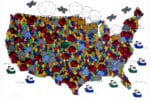
New NPG Paper Highlights the Pragmatism in Immigration Reduction
- NPG
- September 13, 2023
- Press Releases
- 0 Comments
Click here to download a PDF of this release.
Emphasizing Common Sense in the Movement to Curtail Immigration
Alexandria, VA, (September 13, 2023): Negative Population Growth, Inc. (NPG) has released a new Forum paper titled Immigration Reduction: Xenophobia and Racism? Or, Common Sense and Pragmatism in a Crowded Nation? Writing on what she calls the current Great Tsunami of Immigration, long-time journalist Kathleene Parker writes about a U.S. immigration history that – when not “revised” by open-border advocates to their own version of things – shows a nation that saw immigration as something solely to serve the nation’s interests, rather than as a social program to benefit the world. Parker says she is proud to stand with earlier immigration-reduction advocates, such as famous labor activist Cesar Chavez, Black, liberal Congresswoman Barbara Jordan (D.-Tx) and Coretta Scott King who, in the 1990s, helped stop a La Raza effort to make it legal to hire illegal border crossers. Parker, a long-time environmental activist in the American West, adds that she agrees strongly with the 11,000 climate scientists who warn that the current U.S. population explosion, being driven by historically unmatched levels of immigration, will nullify all efforts to address climate change.
Parker walks readers through the early years of immigration into the country, commenting on noteworthy policies and highlighting pertinent decades that perpetuated population growth nationwide. Forty years later, the Great Tsunami of Immigration (1960-2021) brought millions more into the United States. Parker states: “I do recall a nation – in the wake of Paul Ehrlich’s The Population Bomb and Rachel Carson’s Silent Spring – concerned about rapid population growth (then mostly from births) and about our nation’s impacts on ours and the world’s environment – that in an era when media – then owned by thousands of highly competitive news-gathering agencies, still reported fully and honestly about population.”
Speaking on The 1965 Immigration Act, Parker notes that the quotas were removed, and family reunification was emphasized. Parker moves forward in her analysis, sharing: “Because of things like the 1986 Act and migration patterns established by the Bracero Act, exploding illegal immigration became the new hot-button issue, as immigration – legal and illegal – soon far exceeded a million a year, while immigration from 1990 to 2020 exceeded the Great Wave, including 14 million just between 2000 and 2010, versus the 20 million of the entire Great Wave. What immigration, most of it illegal, will be post-Title 42, only time (and the next census) will determine, but we’re experiencing what I call the ‘Great Tsunami of Immigration.’ That tsunami washes over a now highly populated nation, wracked by megadrought, wildfires, hurricanes, and other natural disasters, a huge national debt, decaying infrastructure, and exploding crime rates (often of open-borders origins).”
Immigration to North America precedes the earliest national documents, and once the U.S. had its foundation in place, more people were added. Parker summarizes her work, saying: “You’d have to be naïve – or unaware of what’s really happening – to believe we can continue adding 20 to 30 million more people per decade, as we have post-1990, while meeting our carbon-reduction goals.” She concludes with a somber proposal: “Perhaps,” she writes, “our immigration tsunami is just as dangerous and harmful in its own way as any ocean tsunami sweeping across distant shores.”
Your gift helps publish and distribute materials like this.
powered by Custom Donations


